Traits in Emerging Endosymbiosis for Manipulating Host Cell (INCELL)
Funded by Academy of Finland
Researchers:
- M.Sc. Habibollah Mohammadparast
- Dr. Namrata Baruah
- Collaboration with Dr. Janne Koskimäki
We have identified a new type of endosymbiotic interaction between Methylobacterium extorquens DSM13060, Pseudomonas synxantha DSM13080 and Scots pine (Pinus sylvestris L.). Methylobacterium spp. are the most dominant endosymbiotic species in the cells of meristematic bud tissues of Scots pine.
These bacteria colonize pine seedlings through rhizobia-like mechanisms and increase host growth to the same extent as mycorrhizal fungi. Once inside plant cells, they aggregate around the nucleus and directly interfere with pine metabolism. We elucidate these mechanisms by generating deletion mutants of specific genes and by tracing compound transfer between the organisms. The research will produce essential information on a novel symbiosis by elucidating mechanisms of manipulating host cells by intracellular bacteria. Our aim is to develop new types of biofertilizers for agriculture.
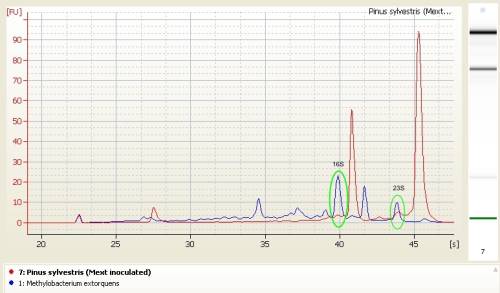
RNA analysis with bioanalyzer
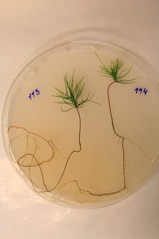
Pine seedlings inoculated with M. extorquens DSM13060
The endophytic community composition of bilberry fruits in response to environmental factors
Researchers:
- Dr. Phuong Nguyen
- Dr. Kaisa Lehosmaa
Wild berries, a well-known natural resource in Finland and Northern Europe, contain various benefits for human health. The health advantages are due to richness of secondary metabolites, so-called phenolic compounds.
We are studying one of the economically most important wild berries in Northern Europe, bilberry (Vaccinium myrtillus L.), which is common in forests of Finland. We have shown that endophytic communities of bilberry fruits depend on the host species and phenolic compounds. In our future projects, we will deepen our understanding on the effect of environmental factors on the endophytic communities of bilberry fruits.
The results of the project are expected to make a valuable contribution towards enhancing the quality and quantity of wild berries as well as reserving and fully exploiting their health advantages.
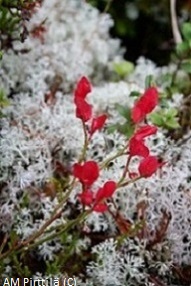
Bilberry (Vaccinium myrtillus L.)
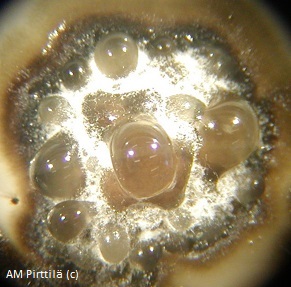
An endophytic fungus
Harnessing moss-microbe symbiosis to safeguard clean water of Finland (MOREWA)
Mosses, nature’s purifier, for reducing land use-derived metal and nutrient loads in catchments (PUREWA)
The common reed Phragmites australis and their microbial symbionts for phytoremediation of mining and municipal wastewaters
Tire dust in northern stormwaters – Mosses and their microbial symbionts in the remediation of nanoplastics (PlastPlanta)
Funded by Academy of Finland
Funded by Kvantum Institute of University of Oulu
Funded by Maj and Tor Nessling Foundation
Researchers:
- Dr. Kaisa Lehosmaa
- Dr. Olga Podolich
- Dr. Phuong Nguyen
- M.Sc. Urooj Rashid
- M.Sc. Elisa Heilmann
- M.Sc. Abrar Hussain Mian
- M.Sc. Wiktor Babis
- M.Sc. Sonja-Maria Mattila
Human-induced processes have led to nitrogen, dissolved organic carbon (DOC), nanoplastic, and heavy metal loads to recipient water bodies and soils, creating an urgent need for sustainable and cost-effective treatment solutions. A number of plants can uptake, store or even volatilize metals and metalloids and nutrients to the atmosphere. Plant-associated microbes play a major role in metal and nutrient uptake, modification, and storage. Microbial symbionts help plants to survive in various and, at times, challenging biological conditions, but their application in bioremediation is a relatively unexplored field of research.
The projects aim to study bioremediation potential of floating hook-moss (Warnstorfia fluitans ), aquatic moss (Fontinalis antipyretica), Sphagnum (S. riparium) and common reed (Phragmites australis ) by identifying mechanisms and roles of symbiotic microbes in metal accumulation and uptake processes of DOC, nanoplastics, and nitrogen. Mosses are adapted to low pH and temperature conditions, and based on previous studies, accumulate effectively nutrients, metals, and metalloids. Common reed is famous for use in phytoremediation of various wastewaters and soils around the globe for the past fifty years. However, participation of microbes in the phytoremediation process, and capacity of reed to remove contaminants from the soil in cold growth conditions are not known. We have identified microbes participating in the uptake and accumulation processes and localized the plant tissues hosting the symbionts and accumulating contaminants. We are employing microbial symbionts for the development of innovate biotechnological solutions for metal-, DOC-, nanoplastic- and nitrogen-rich wastewaters.
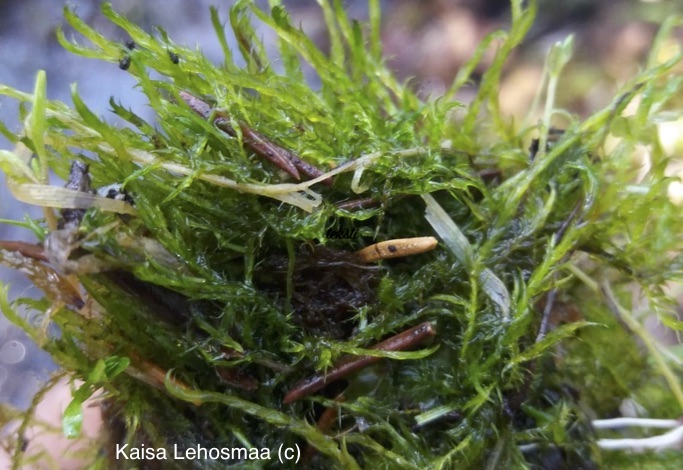
Floating hook-moss (Warnstorfia fluitans)






